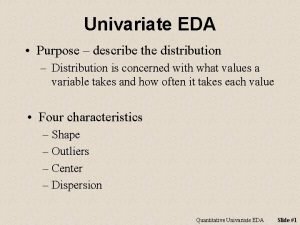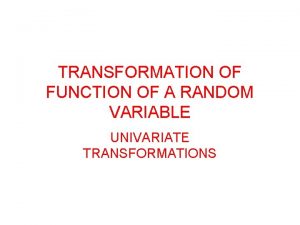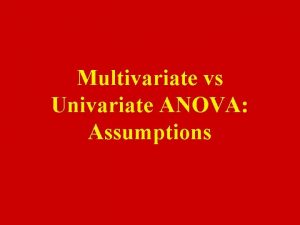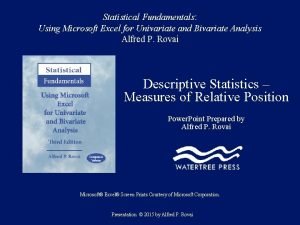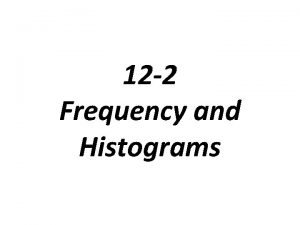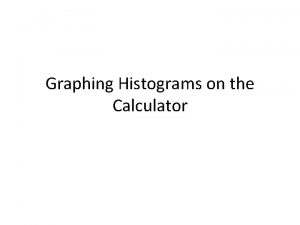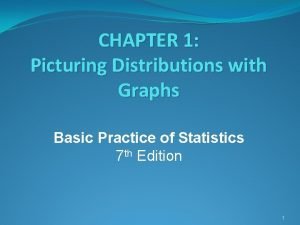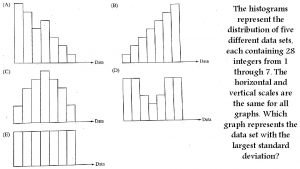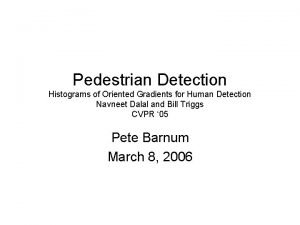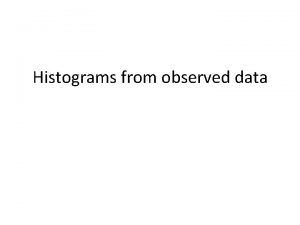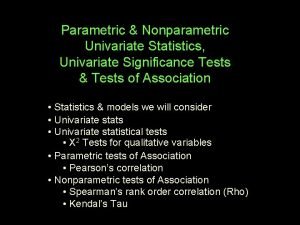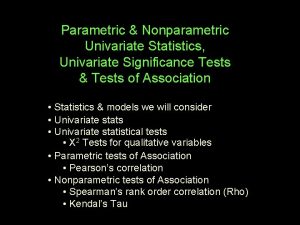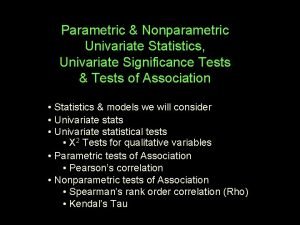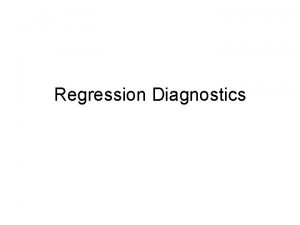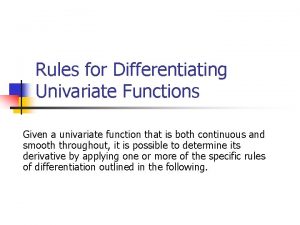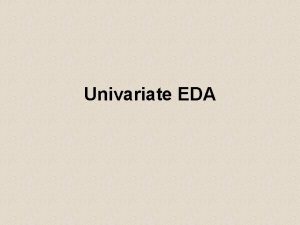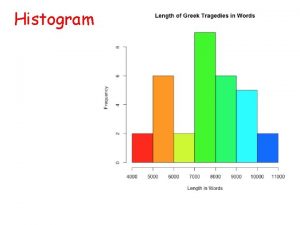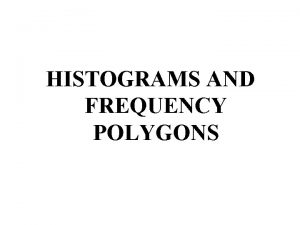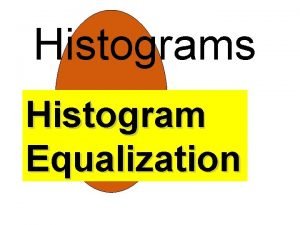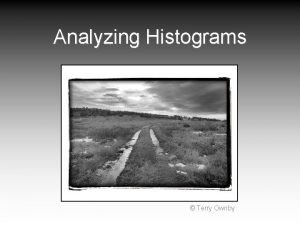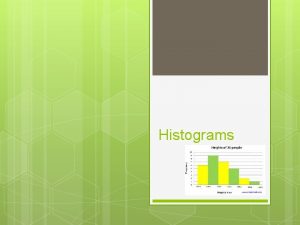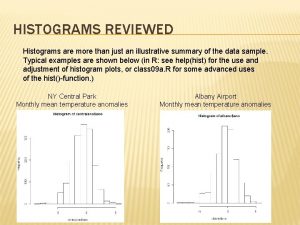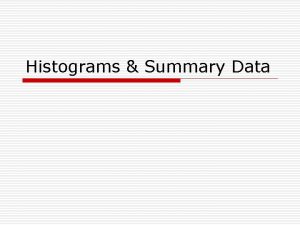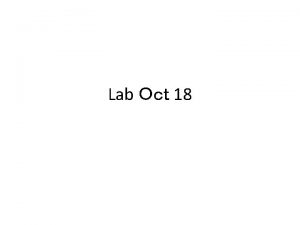Chapter 4 Image Statistics and Histograms Univariate Statistics





















![Alternative Equations for Image Statistics G-1 g p[g] average = g=0 G-1 std dev Alternative Equations for Image Statistics G-1 g p[g] average = g=0 G-1 std dev](https://slidetodoc.com/presentation_image_h2/ee76d257d2913d729d8b0eeb1cb3f628/image-22.jpg)
![Image Statistics entropy = G-1 p[g] log (p[g]) g=0 2 (for all p[g] > Image Statistics entropy = G-1 p[g] log (p[g]) g=0 2 (for all p[g] >](https://slidetodoc.com/presentation_image_h2/ee76d257d2913d729d8b0eeb1cb3f628/image-23.jpg)
![Cumulative Grey Level Distribution P[g] = p[0] + p[1] +. . . + p[g] Cumulative Grey Level Distribution P[g] = p[0] + p[1] +. . . + p[g]](https://slidetodoc.com/presentation_image_h2/ee76d257d2913d729d8b0eeb1cb3f628/image-24.jpg)

![Image Energy rmse = 1 MN M-1 N-1 2 i [m, n] m=0 n=0 Image Energy rmse = 1 MN M-1 N-1 2 i [m, n] m=0 n=0](https://slidetodoc.com/presentation_image_h2/ee76d257d2913d729d8b0eeb1cb3f628/image-26.jpg)

- Slides: 27

Chapter 4: Image Statistics and Histograms

Univariate Statistics - used to describe and assess image quality of one band of imagery Multivariate Statistics - used to describe and assess the relationship between two or more bands of data

Image Statistics Brightness Mean grey level Contrast Variance, Standard deviation Image Energy Root Mean Squared Energy (RMSE) Information Content Entropy

Image Statistics skewness – a measure of the asymmetry of the histogram of an image kurtosis – measure of the sharpness of the peak of an image histogram as compared to a normal distribution covariance – a measure of the joint variation of two bands of data correlation – measure of the interrelation between pixel values

Image Processing Mathematical Notation The following notation is used to describe the mathematical operations applied to the digital remote sensor data: i = a row (or line) in the imagery j = a column (or sample) in the imagery k = a band of imagery l = another band of imagery n = total number of picture elements (pixels) in an array BVijk = brightness value in a row i, column j, of band k BVik = ith brightness value in band k

Image Processing Mathematical Notation BVil = ith brightness value in band l (continued) mink = minimum value of band k maxk = maximum value of band k rangek = range of actual brightness values in band k quantk = quantization level of band k (e. g. , 28 = 0 to 255; 212 = 0 to 4095) µk = mean of band k vark = variance of band k sk = standard deviation of band k

Image Processing Mathematical Notation skewnessk = skewness of a band k distribution (continued) kurtosisk = kurtosis of a band k distribution covkl = covariance between pixel values in two bands, k and l rkl = correlation between pixel values in two bands, k and l Xc = measurement vector for class c composed of brightness values (BVijk) from row i, column j, and band k

Image Processing Mathematical Notation Mc = mean vector(continued) for class c Md = mean vector for class d µck = mean value of the data in class c, band k sck = standard deviation of the data in class c, band k vckl = covariance matrix of class c for bands k through l; shown as Vc vdkl = covariance matrix of class d for bands k through l; shown as Vd

Image Brightness The mean of a single band of imagery composed of n brightness values (BVik) is computed using the formula: The sample mean, mk, is an unbiased estimate of the population mean. For symmetrical distributions, the sample mean tends to be closer to the population mean than any other unbiased estimate (such as the median or mode). Unfortunately, the sample mean is a poor measure of central tendency when the set of observations is skewed or contains an extreme value.

Image Contrast - relates to the variation of image intensity about the mean - image contrast is low when the image is uniformly grey - image contrast is high when the image lacks intermediate shades of grey - can be measured using equations for variance or standard deviation

Image Contrast The variance of a sample is the average squared deviation of all possible observations from the sample mean. The variance of a band of imagery, vark, is computed using the equation: The numerator of the expression is the corrected sum of squares (SS).

Image Contrast The standard deviation is the positive square root of the variance. The standard deviation of the pixel brightness values in a band of imagery, sk, is computed as

Image Histograms


Skewness is a measure of the asymmetry of a histogram and is computed using the formula

A histogram may be symmetric but have a peak that is very sharp or one that is subdued when compared with a perfectly normal distribution. A perfectly normal distribution (histogram) has zero kurtosis. The greater the positive kurtosis value, the sharper the peak in the distribution when compared with a normal histogram. Conversely, a negative kurtosis value suggests that the peak in the histogram is less sharp than that of a normal distribution. Kurtosis is computed using the formula:

Image Histogram or Grey level distribution For an image with G possible intensity values (grey levels) the grey level distribution is defined as: c[g] = the number of pixels with grey level g (for each g=0, 1, . . G-1) p[g] = the relative frequency of grey level g c[g] p[g] = MN

Grey level Distribution plotted as a Histogram

Grey level Distribution plotted as a Histogram

Grey level Distribution plotted as a Histogram

Grey level Distribution plotted as a Histogram
![Alternative Equations for Image Statistics G1 g pg average g0 G1 std dev Alternative Equations for Image Statistics G-1 g p[g] average = g=0 G-1 std dev](https://slidetodoc.com/presentation_image_h2/ee76d257d2913d729d8b0eeb1cb3f628/image-22.jpg)
Alternative Equations for Image Statistics G-1 g p[g] average = g=0 G-1 std dev = 2 (g - average) p[g] g=0 G-1 RMSE = 2 g p[g] g=0
![Image Statistics entropy G1 pg log pg g0 2 for all pg Image Statistics entropy = G-1 p[g] log (p[g]) g=0 2 (for all p[g] >](https://slidetodoc.com/presentation_image_h2/ee76d257d2913d729d8b0eeb1cb3f628/image-23.jpg)
Image Statistics entropy = G-1 p[g] log (p[g]) g=0 2 (for all p[g] > 0) Entropy is sometimes is used to characterize information content in an image. For example an image which is uniformly grey has entropy = 0. The maximum possible entropy occurs when all grey levels are present with equal probability.
![Cumulative Grey Level Distribution Pg p0 p1 pg Cumulative Grey Level Distribution P[g] = p[0] + p[1] +. . . + p[g]](https://slidetodoc.com/presentation_image_h2/ee76d257d2913d729d8b0eeb1cb3f628/image-24.jpg)
Cumulative Grey Level Distribution P[g] = p[0] + p[1] +. . . + p[g] P[g] is the proportion of pixels with grey level value less than or equal to g.

camera image histogram cumulative histogram
![Image Energy rmse 1 MN M1 N1 2 i m n m0 n0 Image Energy rmse = 1 MN M-1 N-1 2 i [m, n] m=0 n=0](https://slidetodoc.com/presentation_image_h2/ee76d257d2913d729d8b0eeb1cb3f628/image-26.jpg)
Image Energy rmse = 1 MN M-1 N-1 2 i [m, n] m=0 n=0 (root mean square image energy) rmse 2 = contrast 2 + average 2

Average 118. 7 Contrast 62. 3 RMS Energy 134. 08 Average 119. 7 Contrast 53. 2 RMS Energy 131. 1
 Univariate analysis tests
Univariate analysis tests Analisa univariat adalah
Analisa univariat adalah Univariate verfahren
Univariate verfahren Univariate analysis spss
Univariate analysis spss Univariate eda
Univariate eda Univariate transformation of random variable
Univariate transformation of random variable Normal equation logistic regression
Normal equation logistic regression Univariate anova
Univariate anova Experimental research design types
Experimental research design types Univariate vs multivariate
Univariate vs multivariate Univariate analysis excel
Univariate analysis excel Frequency tables and line plots
Frequency tables and line plots Histograms and box plots lesson 9-3 answer key
Histograms and box plots lesson 9-3 answer key Histogram when class intervals are unequal
Histogram when class intervals are unequal 12-2 frequency and histograms worksheet answers
12-2 frequency and histograms worksheet answers Histogram algebra 1
Histogram algebra 1 Misleading histograms
Misleading histograms Worksheet on histogram
Worksheet on histogram Histograms calculator
Histograms calculator Cumulative frequency polygon median
Cumulative frequency polygon median One advantage of stemplots over histograms is that
One advantage of stemplots over histograms is that Histogram of oriented gradients for human detection
Histogram of oriented gradients for human detection The histograms below represent the distribution of five
The histograms below represent the distribution of five Histograms of oriented gradients for human detection
Histograms of oriented gradients for human detection Histograms
Histograms How to calculate frequency density
How to calculate frequency density Analog image and digital image
Analog image and digital image Introduction to statistics what is statistics
Introduction to statistics what is statistics




